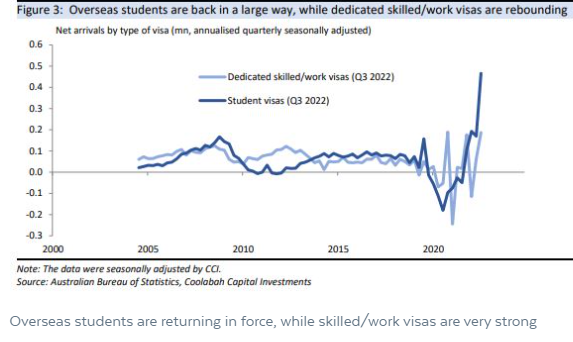In December, the former Morrison Government announced reforms to visa arrangements to ensure a “rapid return of international students”.
The reforms included:
- granting a two year Temporary Graduate visa to Vocational Education and Training (VET) sector graduates; and
- extending the temporary graduate visa from two to three years for masters by coursework graduates.
Shortly afterwards, the Morrison Government doubled the number of hours international students could work each week to 40 hours, effectively turning student visas into low-skilled work visas.
The results were predictable, with an immediate sharp increase in student visa applications from India and Nepal, and Australia seeing a record surge in student visa arrivals:

At last month’s Jobs & Skills Summit, the Albanese Government added further incentives for international students, including:
- Uncapping the number of hours international students can work while studying for another year;
- Extending the length of post-study work visas by two years for ‘skills shortage’ courses; and
- Expanding access to permanent residency by lifting the permanent migrant intake to a record high 195,000.
The incentives are clearly working with a new survey from IDP Education, based on responses from more than 11,000 prospective and current international students, showing that Australia is now the first-choice country for 25% of students, up five percentage points since March. This is only behind Canada, which is the first choice among 27% of students.
In response, business lobby – the Committee for Sydney – has called for a further expansion of post-study work rights and easier permanent residency for international students in a bid to elevate Australia as a study (read immigration) destination:
All students who complete a bachelors degree or above should automatically have the right to four years of work following graduation, not just those who have a degree in an occupation deemed to be in areas of skills shortage, says the Committee for Sydney…
Those who remain in work over that period should [also] be on an [automatic] pathway to permanent residency…
The Committee for Sydney’s proposals would inevitably lead to tens of thousands more poor students from developing nations (e.g. the Indian sub-continent) flooding Australia in order to work and gain permanent residency.
They are also further proof that ‘international education’ is really a people-importing immigration industry rather than a genuine education export industry.
Hilariously, the Committee for Sydney previously complained that rapid population growth had wrecked livability across Sydney:
“The knock-on impacts of the city growing at such a fast pace are strains upon our overall quality of life as well as public infrastructure,” Committee for Sydney executive chairman Michael Rose said…
The elephant in the room is housing affordability…
Everybody who uses public transport in Sydney often enough will have a horror story to tell, and this negative perception has been echoed in the report… road congestion is an increasing concern, with the report flagging that Sydney has recently become more congested more quickly than most of its peer cities…
What does the Committee for Sydney think will happen to livability when thousands more international students flood Sydney? These people will use infrastructure and will require housing. And quality of live will inevitably erode.
The mass immigration ‘Big Australia’ policy pursued by rent-seekers like the Committee for Sydney guarantees falling livability. The solution is a lower number of higher quality international students, not pursuing greater numbers through migration and work incentives.

